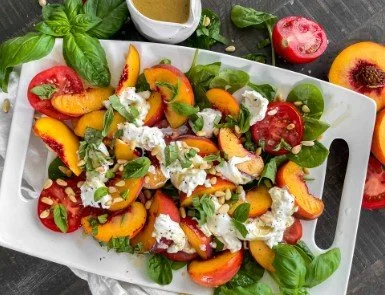Bountiful Abundance
Each week when I’m visiting my fellow vendors I always pose the question, “What do you want me to write about in the blog this week?” Last week there was an overwhelming consensus: yellow peaches and tomatoes. These are the powerhouse fruits of summer. Yes, tomatoes are technically a fruit, but for ketchup’s sake we’ll call it a vegetable. Both are in abundance at the markets. There are multiple varieties of all shapes and colors. They are not selling out as in the early weeks of their arrivals and with the warm weather both are ripening quickly.
Sometimes I look in market goers’ baskets seeing one or two tomatoes and a few peaches thinking to myself, “Who does that?” When I see boxes of tomatoes and crates of yellow peaches toted on a wagon, that’s more like it.
How many of you lost power in the storms last week? I can’t log online, pick up a magazine or newspaper, or listen to the radio without someone mentioning changing weather patterns, climate crisis, and food security. Attention—for those of you in the back of the room this is your chance, the time of year when lots of foods which preserve well are in abundance. If you want food from your farmers instead of the grocery store or imported from south of the equator in the off season now is the time to act. Properly preserved food doesn’t require refrigeration.
Now, I know what you are going to say, you don’t have time and/or you don’t know how. You’ve got Internet, you can figure it out. There are thousands of books with instructions, recipes, and ideas. And as for the time, if I can find time to put up create of yellow peaches and a box of tomatoes, so can you. In addition to the basics, I also manage a wicked batch of bourbon peach BBQ sauce and spicy ketchup, too. There are no more shortages of canning jars, bands, and lids. I see them in the grocery store, at the agricultural outlets, big box stores, and hardware stores. Amazon will bring them to your door, but you’ll have to make a trip to the market for your fresh fruits.
Pro tip: while there is an abundance of yellow peaches and tomatoes at the market right now, pre-order by the crate or case to make packing easier for your farmers.
While I prefer those lovely little San Marzano plum tomatoes for canning whole peeled tomatoes, making puree with an assortment of what is super ripe is equally delicious and useful. Did you know you can also freeze whole tomatoes? Just don’t expect them to be in pristine shape for something like a BLT when you thaw it out. They will strictly be for cooking or juicing. Certainly you can tuck a few tomatoes into the freezer. I have a rule, I don’t break into my tomato stash until the first snow. That’s always such a treat.
There’s the other camp who says they only eat it in season which means they need to find seven ways in which to eat tomatoes and peaches. Yellow peach halves filled with thick yogurt for breakfast. How about a hot red orb sliced into a star of wedges and stuffed with lobster salad? Or chicken salad? Or egg salad? As much as I love to make peach pie, peach cobbler, and peach ice cream, I’ve been leaning toward their savory side. Have you ever grilled yellow peaches? When your coals are hot and ready, simply slice a fresh peach in half and put it cut side down over the heat. You can dress it up a bit with some fresh herbs and honey. Yellow Peaches are the workhorses of the orchards with their firm flesh holding up well to heat.
Yellow peaches will also take the cold. Rustle up a recipe for fresh peach salsa or simply cube up a few peaches, add fresh jalapenos, cilantro, and white onion with a splash of lime juice. It really is that easy. If you’re grain free you don’t have to put it on chips, a nice piece of fish will do. I’ve been combining the two—peaches and tomatoes with fresh basil and burrata drizzled with good olive oil, all which is available at the markets--the ultimate in no-cook fast summer meals.
For all of the fruits in abundance right now, the gadget people have the best option for preservation. It’s one thing to pull the dehydrator out of the basement that your parents used for making beef jerky back in the 70s, but it’s another level to have your own freeze drying unit. Unlike dehydration which removes 60 to 85% of water, freeze drying removes 95 to 99% of water, making foods shelf stable at room temperature while retaining most of the nutritional value. Whether you are a tech bro or a prepper (or both), this equipment is showing up in more homes as a means of putting up seasonal bounty without freezing or canning.
Recipes and preservation methods are your choice, but I’m telling you that now is the time to act for tomatoes and yellow peaches. Your farmers will love you for it.

